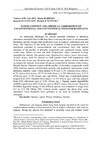Identificador persistente para citar o vincular este elemento:
https://accedacris.ulpgc.es/jspui/handle/10553/55466
| Título: | Tannin content and chemical composition of unconventional and conventional feed for ruminants | Autores/as: | Gil, Vanessa Rey, Luis Barberá, Marta Castañón, José I.R. Ventura, Myriam R. |
Clasificación UNESCO: | 3109 Ciencias veterinarias | Palabras clave: | Opuntia Agave Pisum Hordeum Arundo |
Fecha de publicación: | 2016 | Publicación seriada: | Agriculture and Forestry / Poljoprivreda i Sumarstvo | Resumen: | An interesting challenge for animal nutrition scientists is introduce alternative feedstuffs that would help them overcome the issues of environmental harshness and the forages high production costs in tropical, subtropical and arid areas. The objective of this study was to contribute to the characterization of nutritional potential of unconventional and conventional feed with special attention to the profiles of phenolic compounds and condensed tannin, which could cause effects on meat and milk composition, when consumed in large quantities by animals. The species were: Opuntia ficus-indica, Agave Americano, Arundo donax, used for farmers to feed animals from wild populations and Triticum spp, Avena spp, Hordeum spp and Pisum spp, species natives cultivated as forages for animals, from seeds of species conserved by farmers in the Canary Islands (Spain). Nutrient content and the profiles in secondary compounds would differ between species and that their quantity and qualitative interactions would influence nutritive value. Crude protein (CP) was: 4.2% (Opuntia ficus-indica), 6.7% (Agave Americano), 10.7% (Arundo donax), 11.2% (Hordeum spp), 12.6 % (Triticum spp), 13.9% (Avena spp) and 18.4%, Pisum spp). Condensed tannins ranged from 0.0% (Opuntia ficus-indica ) to 2% (Pisum spp), and total phenols from 0.6% (Hordeum spp) to 9.2% (Pisum spp ). Organic matter digestibility (OMD) ranged from 46% (Triticum spp) to 88.6% (Agave Americano). Based on IVOMD, digestible energy of the different species was estimated to range from 6.5 to 11.8 MJ DE/kg DM. Current results support the thesis that, some alternative local feedstuffs have potential to be used in ruminant feeding strategies. | URI: | https://accedacris.ulpgc.es/handle/10553/55466 | ISSN: | 0554-5579 | DOI: | 10.17707/AgricultForest.62.4.01 | Fuente: | Agriculture and Forestry / Poljoprivreda i Sumarstvo [ISSN 0554-5579], v. 62 (4), p. 5-10 |
| Colección: | Artículos |
Visitas
134
actualizado el 06-abr-2024
Descargas
141
actualizado el 06-abr-2024
Google ScholarTM
Verifica
Altmetric
Comparte
Exporta metadatos
Los elementos en ULPGC accedaCRIS están protegidos por derechos de autor con todos los derechos reservados, a menos que se indique lo contrario.
